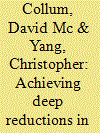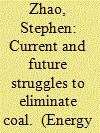|
|
|
Sort Order |
|
|
|
Items / Page
|
|
|
|
|
|
|
| Srl | Item |
| 1 |
ID:
092839


|
|
|
|
|
| Publication |
2009.
|
| Summary/Abstract |
This paper investigates the potential for making deep cuts in US transportation greenhouse gas (GHG) emissions in the long-term (50-80% below 1990 levels by 2050). Scenarios are used to envision how such a significant decarbonization might be achieved through the application of advanced vehicle technologies and fuels, and various options for behavioral change. A Kaya framework that decomposes GHG emissions into the product of four major drivers is used to analyze emissions and mitigation options. In contrast to most previous studies, a relatively simple, easily adaptable modeling methodology is used which can incorporate insights from other modeling studies and organize them in a way that is easy for policymakers to understand. Also, a wider range of transportation subsectors is considered here-light- and heavy-duty vehicles, aviation, rail, marine, agriculture, off-road, and construction. This analysis investigates scenarios with multiple options (increased efficiency, lower-carbon fuels, and travel demand management) across the various subsectors and confirms the notion that there are no "silver bullet" strategies for making deep cuts in transport GHGs. If substantial emission reductions are to be made, considerable action is needed on all fronts, and no subsectors can be ignored. Light-duty vehicles offer the greatest potential for emission reductions; however, while deep reductions in other subsectors are also possible, there are more limitations in the types of fuels and propulsion systems that can be used. In all cases travel demand management strategies are critical; deep emission cuts will not likely be possible without slowing growth in travel demand across all modes. Even though these scenarios represent only a small subset of the potential futures in which deep reductions might be achieved, they provide a sense of the magnitude of changes required in our transportation system and the need for early and aggressive action if long-term targets are to be met.
|
|
|
|
|
|
|
|
|
|
|
|
|
|
|
|
| 2 |
ID:
103402


|
|
|
|
|
| Publication |
2011.
|
| Summary/Abstract |
In 2007, the Government of Canada announced its medium- and long-term greenhouse gas (GHG) emissions reduction plan entitled Turning the Corner, proposed emission cuts of 20% below 2006 levels by 2020 and 60-70% below 2006 levels by 2050. A report from a Canadian government advisory organization, the National Round Table on Environment and Economy (NRTEE), Achieving 2050: A carbon pricing policy for Canada, recommended "fast and deep" energy pathways to emissions reduction through large-scale electrification of Canada's economy by relying on a major expansion of hydroelectricity, adoption of carbon capture and storage for coal and natural gas, and increasing the use of nuclear.
This paper examines the likelihood of the pathways being met by considering the report's proposed energy systems, their associated energy sources, and the magnitude of the changes. It shows that the pathways assume some combination of technological advances, access to secure energy supplies, or rapid installation in order to meet both the 2020 and 2050 targets. This analysis suggests that NRTEE's projections are optimistic and unlikely to be achieved.
The analysis described in this paper can be applied to other countries to better understand and develop strategies that can help reduce global greenhouse gas emissions.
|
|
|
|
|
|
|
|
|
|
|
|
|
|
|
|
| 3 |
ID:
166532


|
|
|
|
|
| Summary/Abstract |
Reductions in coal use necessary to meet the objective of keeping global temperature increase well under 2.0 °C faces serious political economic hurdles. To transition from coal, existing use must be eliminated and new growth in coal consumption must be stymied. Efforts to reduce existing consumption in a speedy manner faces challenges in domestically oriented markets where coal industry coalitions resist anti-coal policy and pursue industry protection. In addition, we identify a serious loophole in coal restraint exercised by a number of the users including: China, Japan and Korea. Continued support for coal capacity expansion abroad in both public and private sectors in these markets appears to reflect the lack of incentives, or sanctions in reining in such external capacity expansion. Such external expansion currently is not counted in nationally determined commitments for the Paris Agreement of the United Nations Framework Convention on Climate Change (Paris Agreement). Without greater national political efforts, the necessary reduction in coal use cannot be achieved.
|
|
|
|
|
|
|
|
|
|
|
|
|
|
|
|
| 4 |
ID:
122134


|
|
|
|
|
| Publication |
2013.
|
| Summary/Abstract |
The arrangements reached at the Doha UN Climate Change Conference for the second commitment period of the Kyoto Protocol are the most important and essential results of the Doha Conference. China played a positive and constructive role. As a preliminary effort to tackle climate change, the Kyoto Protocol system is limited in effect, hence facing an uncertain future. Nevertheless, it is a building block for a future emissions reduction regime.
|
|
|
|
|
|
|
|
|
|
|
|
|
|
|
|
| 5 |
ID:
125635


|
|
|
|
|
| Publication |
2013.
|
| Summary/Abstract |
Carbon capture and storage (CCS) is an effective technology for the mitigation of greenhouse gas emissions from large-scale fossil fuel use. Nonetheless, it is not yet commercially viable on a large scale, and its inclusion into countries' energy planning agendas depends on realistic assessments of its emission reduction benefits.
The use of CCS leads to energy penalties resulting from direct consumption of additional energy, and results in indirect CO2 equivalent emissions outside plant boundaries, due to both energy consumption and leakages. Accounting for these emissions allows for an evaluation of the mitigation benefits of CCS.
This study performs a life-cycle assessment (LCA), with and without CCS, for a coal-fired power plant located in Brazil. Findings show that when indirect emissions are taken into account, a plant which captures 90% of its CO2 will have its CO2 equivalent emissions capture potential, based on a global warming potential metric with a 100-year time horizon, reduced to 72%. The advantage of the use of carbon capture towards climate change mitigation is reduced mainly as a result of an increase in CH4 emissions, significant in the coal-mining stage, an effect which is only taken into account when a LCA is performed.
|
|
|
|
|
|
|
|
|
|
|
|
|
|
|
|
| 6 |
ID:
150825


|
|
|
|
|
| Summary/Abstract |
The key goal of this study was to analyse application of the Green Investment Scheme in the Czech Republic through the Green Savings Programme finalising in 2015. The programme was evaluated in terms of aspects of both reduction effectiveness and economic aspects of the basic subsidy categories: (a) Insulation; (b) Low-Energy Houses; (c) Biomass Boilers; (d) Solar Thermal Systems and (e) Heat Pumps. The essential results of the programme were also covered, including the number of projects supported, the total volume of emission reduction and the volume of financial funding.
|
|
|
|
|
|
|
|
|
|
|
|
|
|
|
|
| 7 |
ID:
125437


|
|
|
|
|
| Publication |
2013.
|
| Summary/Abstract |
In the fall of 2006 the Ports of Long Beach and Los Angeles announced the Clean Air Action Plan (CAAP). Its intent was to greatly accelerate emissions reductions from port activities. The CAAP was unprecedented in several ways: it was a voluntary agreement between two competing ports; it was achieved with the cooperation of local, state and federal agencies; it promised large particulate emissions reductions along with continued port growth, and it had a price tag of $2.1 billion. What explains the Ports' decision to implement the CAAP? We conduct a case study to explore alternative explanations for the CAAP. Using data from interviews, media, and the history of events leading up to the CAAP, we find that the CAAP was a strategic response to social and political pressures that had built up over the previous decade. Its intent was to respond to local concerns and reduce opposition to port growth. The CAAP represents an example of the potential of voluntary efforts to solve environmental problems.
|
|
|
|
|
|
|
|
|
|
|
|
|
|
|
|
| 8 |
ID:
162963


|
|
|
|
|
| Summary/Abstract |
This paper reviews China’s achievements in energy efficiency improvements and air emissions reductions from the electric power sector during the 11th five-year plan (FYP) (2006–2010) and 12th FYP (2011–2015) periods, and discusses the remaining challenges and opportunities for policy formulation. Mandates for closure of small coal-fired power plants (CFPPs), and replacement with large ones, together with the promulgation of air emissions standards and the development of renewable energy projects, have resulted in an improvement of 15% in energy efficiency and a reduction of 91%, 89% and 96% in emission rates of SO2, NOx and PM from China’s electric power sector over the last decade. Compared to the United States, the Chinese electric power generation fleet is more energy efficient and has lower average emissions rates of SO2 and NOx. Despite these achievements, two characteristics of the current system pose serious challenges for China’s clean power development: a) two thirds of China’s power generation still rely on coal, and more CFPPs are being built and approved to be built; and b) high curtailment of renewable energy limits its benefits. We review the root causes of these challenges and highlight opportunities for enacting policies to address them.
|
|
|
|
|
|
|
|
|
|
|
|
|
|
|
|
| 9 |
ID:
113486


|
|
|
|
|
| Publication |
2012.
|
| Summary/Abstract |
This study analyzes current energy and carbon dioxide (CO2) emission trends in China's cement industry as the basis for modeling different levels of cement production and rates of efficiency improvement and carbon reduction in 2011-2030. Three cement output projections are developed based on analyses of historical production and physical and macroeconomic drivers. For each of these three production projections, energy savings and CO2 emission reduction potentials are estimated in a best practice scenario and two continuous improvement scenarios relative to a frozen scenario. The results reveal the potential for cumulative final energy savings of 27.1 to 37.5 exajoules and energy-related direct emission reductions of 3.2 to 4.4 gigatonnes in 2011-2030 under the best practice scenarios. The continuous improvement scenarios produce cumulative final energy savings of 6.0 to 18.9 exajoules and reduce CO2 emissions by 1.0 to 2.4 gigatonnes. This analysis highlights that increasing energy efficiency is the most important policy measure for reducing the cement industry's energy and emissions intensity, given the current state of the industry and the unlikelihood of significant carbon capture and storage before 2030. In addition, policies to reduce total cement production offer the most direct way of reducing total energy consumption and CO2 emissions.
|
|
|
|
|
|
|
|
|
|
|
|
|
|
|
|
| 10 |
ID:
177434


|
|
|
|
|
| Summary/Abstract |
The power sector needs to ensure a rapid transition towards a low-carbon energy system to avoid the dangerous consequences of greenhouse gas emissions. Storage technologies are a promising option to provide the power system with the flexibility required when intermittent renewables are present in the electricity generation mix. This paper focuses on the role of electricity storage in energy systems with high shares of renewable sources. The study encompasses a model comparison approach where four models (-, , , and ) are used to analyse the storage uptake in North America. The analysis addresses the conditions affecting storage uptake in each country and its dependence on resource availability, technology costs, and public policies. Results show that storage may promote emissions reduction at lower costs when renewable mandates are in place whereas in presence of carbon taxes, renewables may compete with other low-carbon options. The study also highlights the main modelling approach shortcomings in the modelling of electricity storage in integrated assessment models.
|
|
|
|
|
|
|
|
|
|
|
|
|
|
|
|
| 11 |
ID:
125732


|
|
|
|
|
| Publication |
2013.
|
| Summary/Abstract |
Quantifying potential renewable energy sources from tourist attractions is a pivotal initial step in developing energy policies and strategies for low-carbon tourist industry development. Although solar energy and wind power have been in use for providing power for tourist attractions, the value of using waste biomass for energy production is still poorly understood. Here we advocate a promising approach that produces energy from green waste created by tourism attractions currently existing in large numbers and is still increasing dramatically. Using the Yangtze River Delta (YRD) of China as an example, we evaluated the potential of utilizing green waste to produce energy from 385 tourist attractions in 16 cities of this region. Our results showed that the total potential energy production using the green waste biomass was estimated at 6740 TJ/yr (1 TJ=1012 J) with an average of 137 GJ/ha/yr (1 GJ=109 J), accounting for 6% (the average of the Yangtze River Delta, some scenic areas up to 93%) of YRD's tourism industry's energy consumption in 2008. The use of green waste for energy production is possible using current technology and could result in a win-win approach by reducing waste and increasing the renewable energy yields.
|
|
|
|
|
|
|
|
|
|
|
|
|
|
|
|
|
|
|
|
|